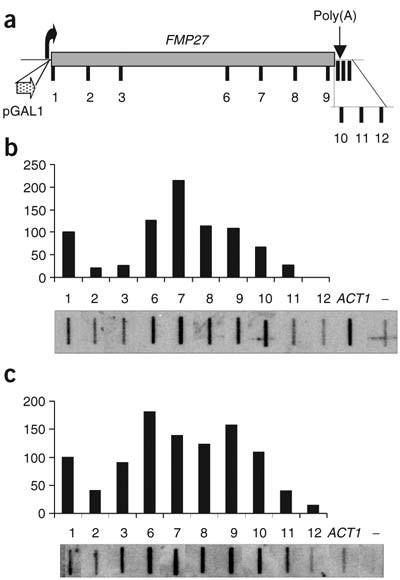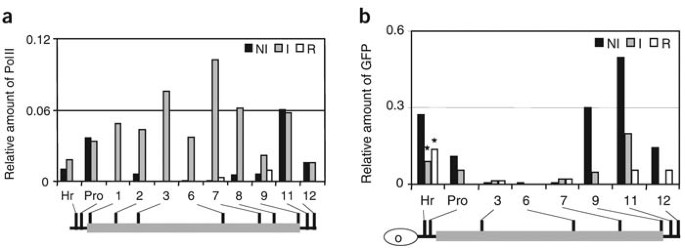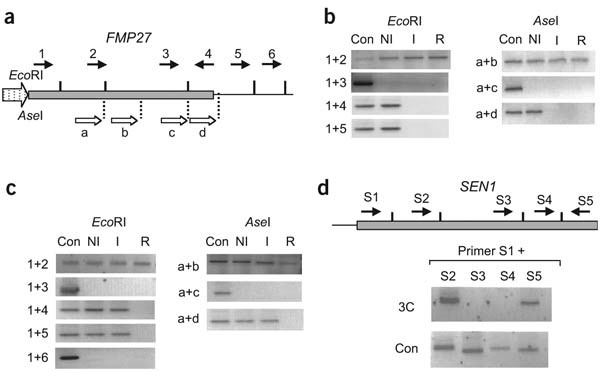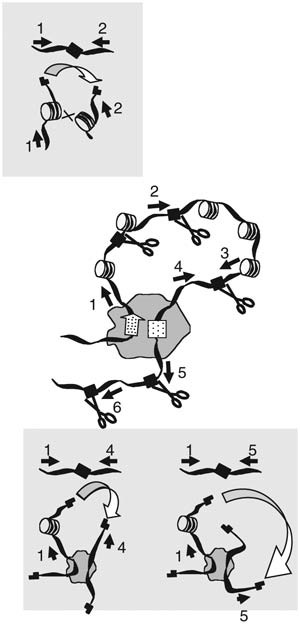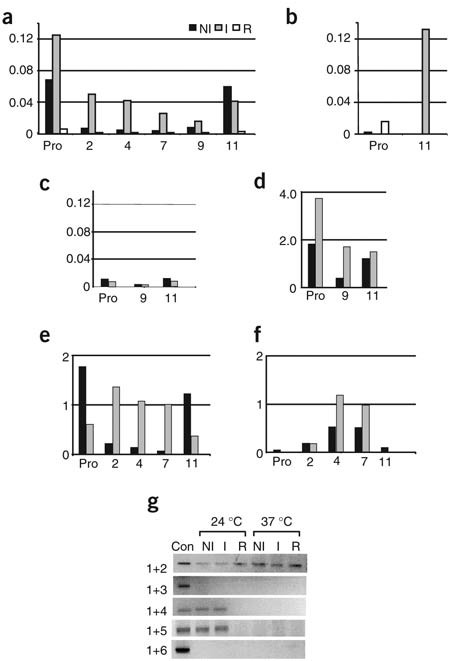Gene loops juxtapose promoters and terminators in yeast (original) (raw)
The genome of S. cerevisiae is highly compact, with 72% comprising open reading frames (ORFs) and an average gene size of 1.4 kb (ref. 3). To distinguish the separate stages of transcription, we investigated two large S. cerevisiae genes, FMP27 and SEN1, with ORFs of 7,887 bp and 6,696 bp, respectively. We first determined the transcript profile across FMP27 by using transcription run-on (TRO) analysis4 (Fig. 1). We observed an accumulation of active polymerase at the 5′ end of the gene, indicating promoter proximal pausing5, and a second accumulation in the ORF, which finally terminated beyond the poly(A) signal (Fig. 1b). We observed a similar TRO profile, though with higher transcription levels, when FMP27 transcription was driven by the GAL1 promoter6 (Fig. 1c).
Figure 1: Density of active PolII across the FMP27 ORF.
(a) FMP27 probes (1–12) used in the TRO analysis. Probe positions are listed in Supplementary Table 1 online. The ORF is depicted by a gray box and the transcriptional start site by a curved arrow. Insertion of the GAL1 promoter (pGAL1) is also indicated. The poly(A) signal is located in the region between probes 10 and 11 (ref. 10). (b,c) Density of actively transcribing PolII across the native FMP27 ORF in wild-type yeast (b) or the heterologous GAL1::FMP27 mutant strain (c) measured by TRO analysis. Quantification of TRO signals obtained by phosphorimage analysis is corrected for background (−), uracil content and hybridization efficiency. The relative transcription of endogenous actin detected by the ACT1 probe indicates that GAL1::FMP27 is transcribed at higher levels than endogenous FMP27.
We next carried out chromatin immunoprecipitation (ChIP) analysis on GAL1::FMP27 with an antibody specific for PolII. The ChIP profile obtained from yeast grown in galactose induction conditions (Fig. 2a) showed large amounts of PolII across the gene. Almost no PolII signal was detected under glucose repression conditions, but we obtained an unexpected result with yeast grown in raffinose (noninducing conditions). In these conditions, the Gal4p transcription factor binds to UASG sites in the GAL1 promoter but is blocked for productive transcription by binding to Gal80p (ref. 7). Despite this block, we observed considerable but asymmetric amounts of PolII over the promoter and terminator regions, though not in the ORF. The amount of PolII also dropped upstream of the promoter in region Hr and downstream of the terminator in region 12 (Fig. 2a).
Figure 2: PolII localizes in the promoter and terminator regions of GAL1::FMP27, causing looping of the intervening ORF.
(a) GAL1::FMP27 cells were grown in raffinose, crosslinked with formaldehyde and then treated for 10 min with raffinose (noninduced, NI), galactose (induced, I) or glucose (repressed, R). Chromatin was immunoprecipitated with antibody to PolII and PCR was done with the indicated primers (see Supplementary Table 2 online). Immunoprecipitations were quantified and are expressed relative to the input. (b) _lac_O-GAL1::FMP27 cells expressing HIS3:_lac_I-GFP were induced with 3-aminotriazole and then subjected to GAL1::FMP27 induction and ChIP analysis as in a, except that antibody to GFP was used. The position of _lac_O upstream of the Hr region is indicated. The asterisk indicates that reduced (75% of normal) sonication conditions were used.
These results suggest that the promoter and terminator regions exist in close spatial proximity under noninducing conditions. To test this hypothesis, we tagged GAL1::FMP27 with an upstream Escherichia coli lac operator in a strain coexpressing a fusion protein of the Lac repressor and green fluorescent protein (GFP; Fig. 2b). Under noninducing conditions, ChIP analysis using antibodies to GFP detected the promoter region and, notably, the terminator region, but not the ORF (Fig. 2b). The signal from the terminator region could result only from crosslinking between the promoter and terminator regions, which therefore must be in close spatial proximity.
We also detected substantial signals at both ends of the gene under inducing conditions, indicating a looped gene structure. As expected, we detected signals over the Hr region adjacent to _lac_O under all three growth conditions. For the repressing and inducing conditions, however, less-stringent sonication conditions were necessary to detect signals. The Hr region may be sensitive to sonication, but under noninducing conditions the loop complex may extend towards the _lac_O region, protecting the linking DNA from fragmentation.
We obtained independent data for the existence of a gene loop structure using the chromosome conformation capture (3C) technique8. In this analysis, chromatin is crosslinked by formaldehyde; fragmented by restriction enzymes; diluted to limit random, intermolecular interactions; and then ligated to covalently join DNA fragments that are crosslinked to the same complex (intramolecular ligation). These ligation products reflect crosslinking between otherwise separate restriction fragments and, with the appropriate primers, are detected by PCR. DNA sequence analysis then confirms that the PCR products derive from intramolecular ligation between fragments with compatible restriction ends.
We carried out 3C analysis of GAL1::FMP27 under noninducing, inducing and repressing growth conditions (Fig. 3), using _Eco_R1 to digest the chromatin preparation. Positive control lanes showed the PCR products expected from the intermolecular ligation of _Eco_RI-digested genomic DNA. Primers 1 and 2 from adjacent restriction fragments generated a PCR product indicative of intramolecular ligation under all growth conditions (Fig. 3b). Crosslinking between adjacent nucleosomes present on actively transcribed FMP27 (refs. 9,10) allowed the formation of this intramolecular ligation product (Fig. 4).
Figure 3: GAL1::FMP27 and SEN1 exist in a loop conformation dependent on the expression state.
(a) GAL1::FMP27, illustrating the _Eco_RI and _Ase_I cleavage sites, the primers used in 3C analysis and the GAL1 promoter (dotted arrow). (b) 3C analysis of GAL1::FMP27. GAL1::FMP27 cells were treated with raffinose (noninduced, NI), galactose (induced, I) or glucose (repressed, R). _Eco_RI or _Ase_I and the primer pairs indicated were used for 3C analysis8; Con denotes the genomic DNA intermolecular ligation control. PCR products associated with intramolecular ligation were sequenced, and the size and sequence of the PCR products obtained with primers of opposite polarity were consistent with intramolecular ligation between the restriction fragments. (c) 3C analysis as in b, except that chromatin was crosslinked in whole cells before the nuclei were extracted. (d) 3C analysis as in b, except that the target gene was SEN1 and the expression conditions were limited to growth in raffinose. 3C denotes intramolecular ligation PCR products.
Figure 4: Model of the proposed GAL1::FMP27 gene loop.
The DNA sequence is drawn as a ribbon. The promoter (spotted arrow) and terminator (spotted box) are contained in a diffuse structure, with the ORF of the gene 'looped out'. The positions of nucleosomes are illustrative and not drawn to scale. The _Eco_RI sites (black box with scissors) and adjacent primers are also shown. Insets above and below the gene loop model show how intramolecular ligation can generate the PCR products detected with primers 1 and 2, primers 1 and 4 and primers 1 and 5. X denotes a crosslink between adjacent nucleosomes. Curved arrows indicate interaction and subsequent intramolecular ligation between the _Eco_RI ends of DNA fragments.
The absence of PCR product with primers 1 and 3 under all conditions indicated that these nonadjacent _Eco_RI fragments did not ligate and consequently were not in close spatial proximity. By contrast, primers 1 and 4 and primers 1 and 5 both produced products indicative of intramolecular ligation only under noninducing conditions. Presumably, these DNA fragments are held in close proximity through a complex at the base of the proposed gene loop (Fig. 4). The product from the oppositely orientated primers 1 and 4 lacked two internal _Eco_RI fragments, again indicating that intramolecular ligation had occurred.
Analysis with a second restriction enzyme, _Ase_I (Fig. 3), confirmed that adjacent _Ase_I fragments underwent intramolecular ligation (primers a and b), whereas nonadjacent fragments did not ligate (primers a and c). The more distant fragments generated intramolecular ligation products detected by primers a and d. These data show that GAL1:FMP27 exists in a loop conformation under noninducing conditions (Fig. 4), as predicted from the GFP-targeted ChIP experiment (Fig. 2b). In particular, the intramolecular ligation products detected by primers 1 and 4, primers 1 and 5 and primers a and d are all compatible with a complex forming between the promoter and terminator regions (Fig. 4). Notably, when the 3C technique was altered so that whole cells were treated with formaldehyde before chromatin extraction, intramolecular ligation products were detected with primers 1 and 4, primers 1 and 5 and primers a and d under both noninducing and inducing conditions (Fig. 3c).
Because the ligation products were undetected in repressing conditions, the gene loop conformation is not a consequence of DNA curvature. Instead, we predict that gene loop formation is connected to the transcriptional status of the gene (Fig. 5). These data agree with those from the _lac_O ChIP analysis (Fig. 2b), which imply that GAL1::FMP27 is in a looped conformation under inducing conditions. To define this loop structure further, we used an additional primer pair (primers 1 and 6), but this pair gave no ligation product, indicating that the loop structure does not extend beyond the terminator region. These data are consistent with those from the lacO ChIP analysis (Fig. 2b), which also indicated that the loop structure was restricted to the end of FMP27.
Figure 5: Phosphorylation at Ser5 of PolII CTD is required for gene loop conformation.
(a–f) ChIP analysis of GAL1:FMP27 as in Figure 2a, but using the following antibodies, strains and growth temperatures. (a) Antibody to CTD phosphorylated at Ser5 in wild-type strain at 30 °C. (b) Antibody to CTD phosphorylated at Ser2 in wild-type strain at 30 °C. (c) Antibody to CTD phosphorylated at Ser5 in _kin28_ts-4 strain at restrictive temperature (37 °C). (d) Antibody to Kin28p in wild-type strain at 37°C. (e) Antibody to PolII in wild-type strain at 37 °C. (f) Antibody to PolII in _kin28_ts-4 strain at restrictive temperature (37 °C). ChIP signal levels are not comparable between antibodies. Positions of PCR products are shown in Figure 2a. (g) 3C analysis of GAL1:FMP27 as in Figure 3c using _kin28_ts-4 strain grown under permissive (24 °C) and restrictive (37 °C) temperatures.
Similarly, 3C analysis on SEN1 (Fig. 3d) showed that adjacent _Eco_RI sites resulted in intramolecular ligation products (detected by primers S1 and S2), whereas the nonadjacent _Eco_RI fragments (primers S1 and S3 and primers S1 and S4) did not. Notably, we detected a ligation product with primers S1 and S5 that lacked the three internal _Eco_RI fragments, indicating that these distant _Eco_RI fragments underwent intramolecular ligation. This finding provides evidence for a loop structure between the promoter and terminator regions of SEN1. 3C analysis on the endogenous FMP27 gene driven by its natural promoter showed intramolecular ligation between terminal fragments, indicating that wild-type FMP27 also exists in a looped conformation (data not shown).
Transcription elongation is coordinated by differential phosphorylation of the PolII C-terminal domain (CTD) heptad repeat at Ser5 and Ser2 (by the Kin28p and Ctdk1 kinases, respectively) with phosphorylation at Ser5 present early and at Ser2 present later in elongation11. We did ChIP analyses on GAL1::FMP27 with antibodies specific for phosphorylated Ser5 and phosphorylated Ser2 (Fig. 5a,b). As expected, the Ser5 phosphorylation signal was high over the promoter and dropped to lower levels in the ORF, whereas the Ser2 phosphorylation signal was detectable only over the termination region under inducing conditions. Notably, the promoter- and terminator-specific PolII signals (Fig. 2a) obtained under noninducing conditions were derived from PolII phosphorylated at Ser5. Thus, PolII is located in an elongation-competent mode at both ends of the gene (Fig. 5a). We also observed some PolII phosphorylated at Ser5 in the termination region of GAL1::FMP27 under inducing conditions.
We finally investigated whether the gene loop is dependent on CTD phosphorylation by using Ser5 kinase (Kin28p) temperature-sensitive mutants12. As expected, ChIP analyses detected very little PolII phosphorylated at Ser5 on GAL1::FMP27 in the _kin28_ts-4 strain (NKY 4044) grown under restrictive conditions (Fig. 5c). In addition, Kin28p was localized to both ends of the gene under noninducing conditions (Fig. 5d). When we re-examined the PolII profile over GAL1::FMP27 in the _kin28_ts-4 as compared to wild-type strains grown under restrictive conditions, we obtained a marked, deregulated PolII profile under both noninducing and inducing growth conditions (Fig. 5e,f). PolII accumulated in the ORF but not in the promoter or terminator regions.
These data suggest that Kin28p kinase activity, which phosphorylates components of the PolII transcription complex including Ser5 in the CTD, is required for gene loop formation. We therefore carried out 3C analysis of GAL1::FMP27 using the _kin28_ts-4 mutant strain under both permissive (24 °C) and restrictive (37 °C) temperature conditions (Fig. 5g). Because all previously defined intramolecular ligation products (obtained with primers 1 and 4 and primers 1 and 5) were absent at 37 °C, we suggest that this gene loop structure is dependent on the initial transcriptional activation of PolII by Kin28p (ref. 12).
Our results provide an explanation for some apparently contradictory observations. For example, the transcription factor TFIIB is associated with Ssu72p (refs. 13,14) and Sub1p (ref. 15), both of which are also involved in mRNA 3′ formation. Similarly, the cleavage polyadenylation specificity factor is a component of TFIID16. These observations led to the proposal that some factors that are required for mRNA 3′-end formation load onto the gene at the promoter and then 'piggy-back' on the PolII elongation complex across the gene to the terminator region. By contrast, ChIP analysis on several S. cerevisiae genes showed that cleavage or polyadenylation factors are associated only with the terminator regions17.
We suggest that the apparent duality of some factors in mRNA 3′-end processing and transcription may be explicable by gene looping (Fig. 4). The observations that Kin28p is physically present in the loop complex and that its activity is required for loop formation suggest that gene loops are associated with early transcriptional activation. Gene loops may function to proofread control sequences before efficient elongation, or they may be precursors to a reinitiation scaffold18. Notably, the alterations in the loop structure that were observed when GAL1::FMP27 gene was induced could reflect modifications to this scaffold after the first round of transcription.
Genome-wide analysis of gene expression in S. cerevisiae shows that adjacent genes often share regulatory sequences, indicating the presence of chromosomal expression domains19,20. We predict that, whereas single-gene loops may exist for larger genes such as FMP27 and SEN1, smaller genes may form multigene loops encompassing adjacent genes. Similarly, the periodic organization of the yeast genome is consistent with loop structures that facilitate the dynamic association of coregulated genes in three dimensions21. In mammals, much larger genes may possess more complex loop structures. The locus control region of the β-globin gene cluster forms a loop structure with downstream globin gene promoters22,23. This locus control region mediates transcriptional activation by promoting phosphorylation of PolII at Ser5 in the CTD at the β-globin gene promoter, rather than by setting up the preinitiation complex24. These studies resonate with the GAL1::FMP27 gene loop structure, which is associated with phosphorylation of PolII at Ser5 in the CTD and dependent on Kin28p activity. We suggest that gene loops may be a common feature of gene activation by promoting efficient transcriptional elongation.
